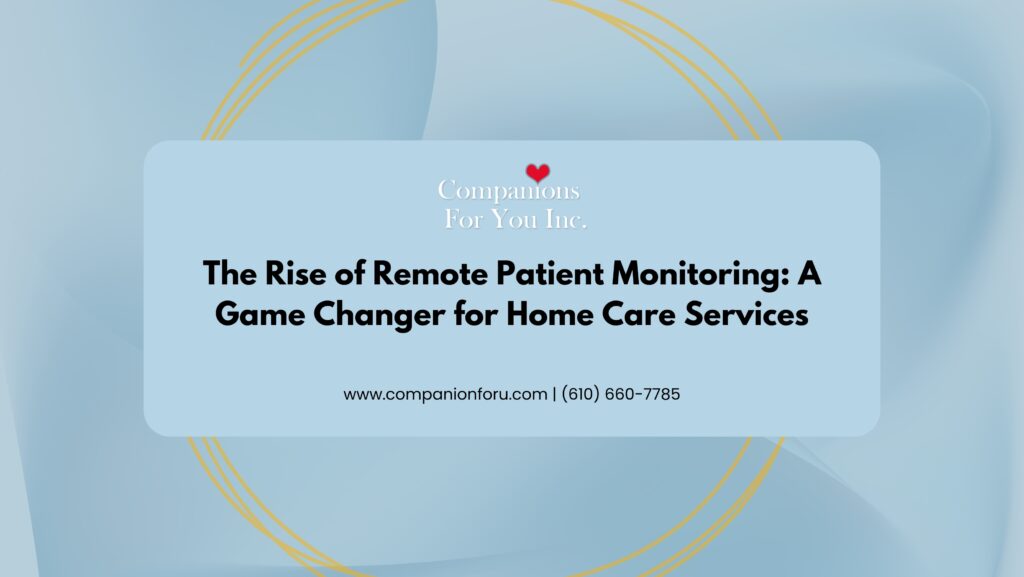As the demand for home care services continues to grow, the integration of technology has become essential in providing high-quality care. One of the most significant advancements in recent years is Remote Patient Monitoring (RPM). This technology is revolutionizing the way home care is delivered, offering numerous benefits for both caregivers and seniors. In this blog, we will explore the impact of RPM on home care services and how it is transforming the industry.
What is Remote Patient Monitoring (RPM)?
Remote Patient Monitoring involves the use of digital technologies to collect medical and health data from individuals in one location and electronically transmit that information securely to healthcare providers in a different location for assessment and recommendations. RPM includes devices like blood pressure monitors, glucose meters, heart rate monitors, and other sensors that track vital signs and health conditions in real-time.
The Benefits of RPM for Seniors
Remote Patient Monitoring offers several advantages that enhance the quality of care for seniors:
- Continuous Monitoring: RPM devices provide real-time data on a senior’s health status, allowing caregivers to monitor vital signs continuously. This enables the early detection of potential health issues, reducing the risk of emergencies.
- Increased Independence: With RPM, seniors can manage their health conditions from the comfort of their homes. This technology supports their independence while ensuring they receive the necessary medical attention.
- Timely Interventions: By tracking health metrics in real-time, RPM allows for timely medical interventions. Caregivers can respond quickly to any abnormalities, preventing complications and hospitalizations.
- Enhanced Care Coordination: RPM facilitates better communication between seniors, caregivers, and healthcare providers. This coordinated approach ensures that everyone involved in the care process is informed and can make well-informed decisions.
Implementing RPM in Home Care
The integration of RPM into home care services requires careful planning and execution. Here are some steps to ensure successful implementation:
- Choosing the Right Devices: Select RPM devices that are user-friendly and reliable. It’s crucial to choose technology that seniors can easily operate and that provides accurate data.
- Training for Caregivers and Seniors: Proper training is essential for both caregivers and seniors to ensure they understand how to use the devices and interpret the data. This includes troubleshooting common issues and knowing when to seek medical advice.
- Data Security: Protecting the privacy and security of health data is paramount. Ensure that all RPM devices and systems comply with regulations such as HIPAA to safeguard sensitive information.
- Regular Monitoring and Follow-Up: Establish protocols for regular monitoring of the data collected by RPM devices. Caregivers should review the data frequently and follow up with healthcare providers as needed to address any concerns.
Companions For You Inc.: Leading the Way in RPM Integration
At Companions For You Inc., we recognize the importance of leveraging advanced technology to enhance our home care services. Our commitment to integrating Remote Patient Monitoring ensures that our clients receive the highest level of care while maintaining their independence. Visit our In-Home Care page to learn more about our innovative approaches to home care.
Challenges and Considerations
While RPM offers numerous benefits, there are also challenges that need to be addressed:
- Technology Adoption: Some seniors may be hesitant or have difficulty using new technology. It’s important to provide adequate support and training to ease this transition.
- Cost: The initial investment in RPM devices and systems can be significant. However, the long-term benefits and potential cost savings from reduced hospitalizations can outweigh these initial costs.
- Data Overload: The continuous stream of data from RPM devices can be overwhelming. Caregivers need to have protocols in place to manage and interpret this data effectively.
Conclusion
Remote Patient Monitoring is undeniably a game changer for home care services. By providing continuous, real-time monitoring of seniors’ health, RPM enhances the quality of care, supports independence, and improves health outcomes. As technology continues to advance, the integration of RPM into home care will become even more seamless and beneficial.For more information on how RPM is transforming home care services, visit our Google Business Profile.






